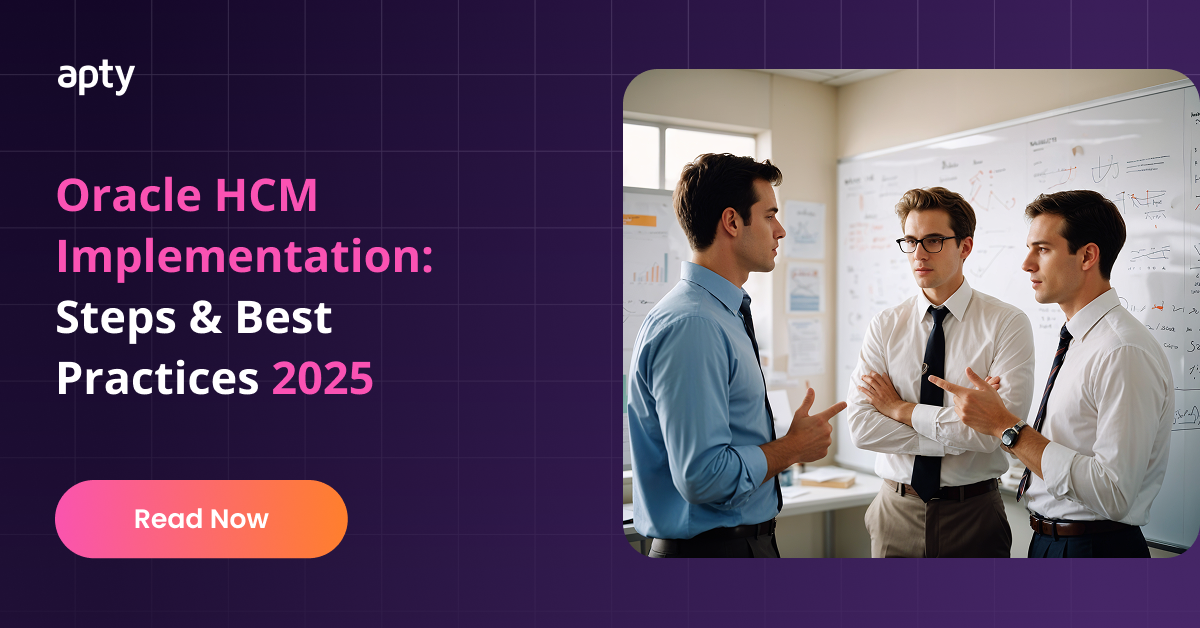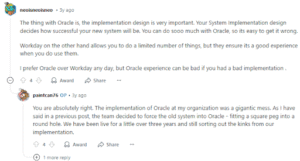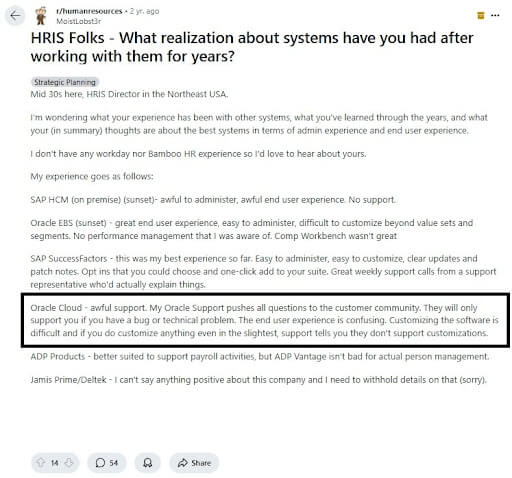Table of Contents
- What Is Oracle HCM Implementation?
- 9 Practical Steps to Oracle HCM Implementation
- Step #1: Conduct a Thorough Needs Assessment
- Step #2: Align HCM Strategy With Business Objectives
- Step #3: Determine Job Structures Within Your Company
- Step #4: Prioritize Data Accuracy and Seamless Migration
- Step #5: Invest in User Training and Change Management
- Step 6: Consider Integrations
- Step #7: Use a Phased Implementation Approach
- Step #8: Ongoing Monitoring and Optimization
- Step #9: Establish Strong Post-Implementation Support
- Challenges in Oracle HCM Implementation
- Apty + Oracle HCM: Smarter Adoption, Stronger Results
- FAQs
Oracle’s Human Capital Management (HCM) system turns fragmented HR chaos into one powerful system, automating tasks, unifying data, and giving leaders real-time insights to drive smarter decisions.
What makes Oracle HCM stand out isn’t just the technology—it’s the adaptability, extensibility, and ability to serve as a single, reliable source for all HR data.
But here’s the catch: even the best system is only as good as its setup. Implementing an HR platform isn’t a routine task. It’s the moment that determines success. And nowhere is this truer than with Oracle.
If you’re ready to swap HR headaches for a system that truly works for your people and processes, you’re in the right place. This is your insider’s guide to Oracle HCM implementation. Let’s get started!
What Is Oracle HCM Implementation?
Oracle HCM implementation configures and launches the platform to fit your organization’s unique needs. It consistently ranks as a top choice among HR platforms, and for good reason.
From recruitment and onboarding to payroll, performance management, and workforce analytics, Oracle HCM brings everything HR teams need into one powerful system.
For growing businesses, Oracle HCM implementation is critical.
As teams expand, manual processes break down, data gets scattered, and decision-making slows. A successful HCM implementation creates one unified system that scales with your business, automates key processes, and provides real-time insights to help leaders make smarter, faster decisions.
9 Practical Steps to Oracle HCM Implementation
Oracle HCM can transform how you manage HR, but a successful rollout takes more than just turning it on. Follow these steps to get it right from day one.
Step #1: Conduct a Thorough Needs Assessment
Successful Oracle HCM implementation starts with understanding your real HR needs, the pain points today and the workforce goals for tomorrow. Skip this step, and you risk an overbuilt, misaligned system that frustrates users and drives up costs.
The fix? Work with HR, payroll, IT, and managers to map what’s broken and what needs to evolve. From there, it’s all about mapping those insights directly to Oracle HCM’s features and configuring processes, modules, and workflows that make sense for your business.
For example, if onboarding is manual and slow, simply replicating that process in Oracle HCM wastes the chance to automate, streamline, and improve the employee experience.
Step #2: Align HCM Strategy With Business Objectives
Before configuring a single screen in Oracle HCM, step back. What’s your company trying to achieve? Are you expanding into new markets? Cutting costs? Trying to improve retention or engagement?
If aggressive hiring is a priority, your HCM workflows need to keep up. Without faster approvals, automated onboarding, and clear visibility into hiring pipelines, HR becomes a bottleneck instead of a growth driver.
The bottom line: Oracle HCM works best when built to serve larger business goals, not just HR’s immediate needs. Starting with clear business goals ensures every process, metric, and module supports your company’s most important outcomes.
Step #3: Determine Job Structures Within Your Company
Establishing clear and consistent job structures is critical before configuring Oracle HCM. This means defining job roles, hierarchies, and reporting lines across every department.
Why is this so important? Your job architecture directly impacts payroll, performance management, approvals, reporting, and workforce planning. Poorly defined structures lead to inaccurate reporting, workflow failures, and broken role-based access controls.
For example, data migration becomes far more complex if teams use inconsistent job titles or unclear reporting lines. Even after going live, HR teams may struggle with permission issues or approval chains that don’t match your org chart.
Taking the time to audit, standardize, and align job structures before you configure Oracle HCM streamlines implementation and future-proofs your HR processes, making them easier to scale as your organization grows.
Step #4: Prioritize Data Accuracy and Seamless Migration
Picture this: a company migrates from a customized on-prem HR system to Oracle HCM but skips data cleansing to stay on schedule.
After going live, they find hundreds of misclassified job titles, broken approval workflows, and compensation reports they can’t trust. Fixing it takes months, draining HR’s time and leadership’s confidence. This is why data migration is crucial.
Legacy data is often messy, with inconsistencies, duplicates, and outdated records lurking beneath the surface. Successful migrations start with data cleansing and mapping, ensuring clean, well-structured data flows into Oracle HCM.
Running parallel payrolls and reconciling records after migration helps catch any lingering errors before they snowball.
Step #5: Invest in User Training and Change Management
Successful Oracle HCM adoption hinges on what the system can do and how well your people can use it. Traditional training methods, like manuals and classroom sessions, often fall short when applied to a system as robust as Oracle HCM.
That’s where Apty comes in.
A platform like Apty provides real-time, in-app guidance tailored to each role, walking users through tasks step-by-step right inside Oracle HCM. This reduces training time, boosts confidence, and helps users adopt new processes faster, all while minimizing dependence on IT and support teams.
To maximize adoption, businesses should also design role-based training programs, ensuring every user learns only the tools, processes, and workflows relevant to their role, such as payroll processing, talent management, or employee self-service.
Step 6: Consider Integrations
Integrating Oracle HCM with your enterprise resource planning (ERP), payroll, tax engines, and even recruitment platforms ensures workforce data flows seamlessly across systems. This eliminates manual workarounds, reduces errors, and gives leaders a complete view of workforce costs, performance, and planning.
The integrations that matter most go far beyond basic payroll feeds. For example, connecting Oracle HCM to your ERP system (like Oracle ERP or SAP) ties workforce costs directly into budgeting and project staffing.
Linking to global tax engines ensures payroll tax compliance across different jurisdictions. Integration with identity and access management (IAM) platforms keeps access secure and ensures employees only see what they need, based on their role.
Failing to map these critical integration points upfront can create data silos, inconsistent reporting, and operational headaches. To avoid this, businesses must audit their technology stack early, identify where Oracle HCM fits, and design integrations that support today’s workflows and tomorrow’s growth.
Step #7: Use a Phased Implementation Approach
Suppose a global retailer is rolling out Oracle HCM across global teams without a pilot phase.
Within days, payroll errors, missing employee records, and unfamiliar workflows overwhelm HR teams, leading to delayed paychecks, frustrated employees, and emergency fixes that derail business as usual. This kind of chaos is exactly why seasoned implementation experts recommend a phased rollout instead of a ‘big bang’ launch.
Start with a pilot deployment in one location, department, or business unit. This smaller-scale go-live helps teams validate system configurations, test critical workflows like payroll and performance reviews, and gather real user feedback before expanding further.
Phased rollouts also reduce risk and give HR and IT time to refine training, address gaps, and optimize data flows between Oracle HCM and other systems. Companies that follow this approach consistently report faster adoption, fewer disruptions, and stronger user confidence when the system goes enterprise-wide.
Step #8: Ongoing Monitoring and Optimization
Going live isn’t the finish line, it’s the starting point for continuous improvement. The primary task is to track system usage and user behavior. For example, if data shows employees abandoning performance review workflows halfway through, that’s a red flag for confusing processes or unclear instructions.
Similarly, if payroll teams revert to spreadsheets to handle calculations outside the system, that signals configuration gaps that need addressing.
Gather feedback from HR teams, managers, and employees alongside system data. A digital adoption platform (DAP) like Apty doesn’t just provide training. It tracks how users interact with Oracle HCM, highlights drop-off points, and enables in-app contextual guidance to help users when and where they need it most.
So, if many managers struggle with completing compensation reviews, Apty can trigger step-by-step walkthroughs tailored specifically to that process.
Based on real-world usage data provided by Apty PULSE, regular system reviews also help HR and IT teams adapt configurations, refine workflows, and add new features as business priorities shift.
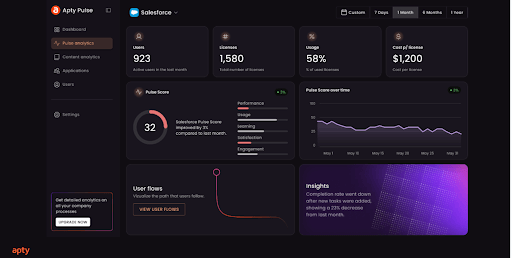
Step #9: Establish Strong Post-Implementation Support
Strong post-implementation support is essential to ensuring Oracle HCM continues to deliver value as your business evolves. This starts with a dedicated HR technology team responsible for system governance, regular updates, and fast issue resolution.
Ongoing feedback loops help surface usability challenges and changing process needs. With Apty, companies can further track how employees interact with Oracle HCM, identify friction points, and deliver real-time validations and end-user support through a centralized knowledge base.
Challenges in Oracle HCM Implementation
For organizations rolling out Oracle HCM, the implementation phase brings its fair share of hurdles. Here are seven key Oracle HCM challenges to watch for:
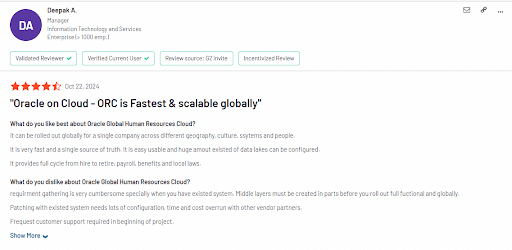
Data Migration
A modern HCM platform acts as the central nervous system for your entire HR function. It houses everything from employee compensation and benefits to leave balances, training records, performance data, and more.
Data migration is, without question, one of the most complex and high-risk phases of any Oracle HCM implementation. Poorly structured data, inconsistent formatting, and mismatched fields can trigger errors, break processes, and lead to unreliable reporting.
Pro Tip: To get it right, organizations should invest in three critical areas: partnering with an experienced Oracle implementation expert, thoroughly cleansing and standardizing data before migration even begins, and building an internal team capable of maintaining and optimizing the system post-go-live.
Employee Onboarding and Training
One of the most overlooked challenges in Oracle HCM implementation is ensuring that every user can confidently navigate and use the system once it’s live.
Oracle HCM’s flexibility and breadth are strengths, but they also mean a steep learning curve, especially for organizations transitioning from more straightforward tools to manual processes.
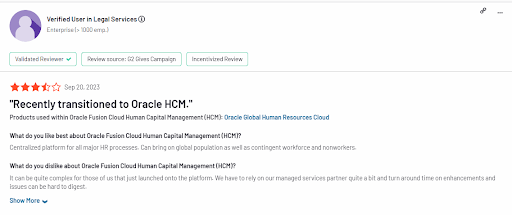
Traditional training methods, like one-time workshops or static manuals, rarely provide lasting value. Employees forget what they learned, processes evolve, and system updates introduce new functionality.
Without effective onboarding and ongoing training, companies risk low adoption, user frustration, costly data entry errors, and underutilisation of the platform’s full capabilities. This ultimately weakens the entire implementation’s return on investment (ROI).
Pro Tip: Use Apty’s DAP to deliver real-time guidance, automate training, and reinforce key workflows, ensuring employees quickly adapt to Oracle HCM and use it effectively.
End-User Support
With a platform as robust and wide-reaching as Oracle HCM, employees and HR administrators will inevitably encounter questions, confusion, and occasional system issues.
The challenge? Relying solely on Oracle’s standard support can quickly become frustrating.
Routine usability questions, configuration hiccups, and minor but persistent bugs rarely get the attention they deserve. In many cases, response times can be slow unless an issue qualifies as Severity 1 or 2, and lower-priority requests are often deprioritized or left unresolved for extended periods.
Give your team the tools to solve issues on their own, so they’re not stuck waiting on support. A strong internal strategy keeps things moving and frustration low.
Pro Tip: Pair your Oracle HCM implementation with a platform like Apty to give employees and HR teams instant, in-app guidance, multi-language support, and self-service help, reducing support tickets and keeping work moving without the wait.
Change Management and Communication
Without clear communication and a well-structured change management strategy, companies risk confusion, resistance, and disengagement, all of which can stall adoption.
This is especially true with a system as comprehensive as Oracle HCM, which touches everything from payroll and performance reviews to self-service benefits and time tracking.
Effective change management also goes beyond kick-off emails and town halls. It requires ongoing reinforcement, real-time support, and a clear roadmap that helps employees understand not just the initial rollout but the long-term evolution of the platform.
Pro Tip: Keep employees informed and confident by embedding change announcements, contextual tooltips, and interactive walkthroughs directly into Oracle HCM with Apty.
Apty + Oracle HCM: Smarter Adoption, Stronger Results
Oracle HCM implementation challenges can be complex, especially when adapting employees to new processes, workflows, and interfaces. Apty can be your post-implementation partner to navigate change, identify friction points, and deliver in-app guidance exactly when users need it.
It empowers your HR teams, payroll staff, and employees to navigate Oracle HCM confidently from day one. This reduces errors, shortens training time, and proactively fixes process gaps.
And the result? Higher adoption rates, more accurate data, and a stronger return on your Oracle HCM investment.
Book a demo to find out how leading companies use Apty to unlock the full potential of Oracle HCM.
FAQs
-
What is Oracle HCM implementation?
Oracle HCM implementation is the process of setting up and deploying Oracle’s Human Capital Management (HCM) Cloud application to manage HR processes such as recruitment, payroll, performance management, and employee records. This involves configuring the system, migrating data, testing, and training users to ensure the solution meets the organization’s HR needs.
-
What are the steps for Oracle implementation?
Oracle HCM implementation involves key steps:
- Project planning: Assign roles, select offerings, and define foundational settings.
- Enterprise and workforce structures: Set up legal entities, business units, jobs, and departments.
- Person and employment records: Configure person types, name formats, and assignment statuses.
- Data migration: Use Oracle’s batch data loader and validate data accuracy.
- Security and approvals: Configure role-based access and approval workflows.
- Testing: Conduct functional, integration, and UAT testing with real-time user feedback.
- Training and go-live: Equip users, launch the system, and provide post-go-live support.
Using Apty’s DAP during and after go-live accelerates adoption, reduces errors, and ensures a smooth transition.
